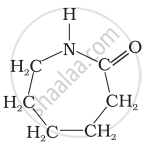Advertisements
Advertisements
Question
Which of the following monomers form biodegradable polymers?
(i) 3-hydroxybutanoic acid + 3-hydroxypentanoic acid
(ii) Glycine + amino caproic acid
(iii) Ethylene glycol + phthalic acid
(iv) Caprolactum
Solution
(i) 3-hydroxybutanoic acid + 3-hydroxypentanoic acid
(ii) Glycine + amino caproic acid
Explanation:
Poly β-hydroxybutyrate – co-β-hydroxy valerate (PHBV) It is obtained by the copolymerisation of 3-hydroxybutanoic acid and 3 - hydroxypentanoic acid. PHBV is used in speciality packaging, orthopaedic devices and in controlled release of drugs. PHBV undergoes bacterial degradation in the environment.
Nylon-2nylon 6: It is an alternating polyamide copolymer of glycine \[\ce{H2N - CH2 - COOH}\] and aminocaproic acid \[\ce{[H2N(CH2)5COOH]}\] and is biodegradable.
APPEARS IN
RELATED QUESTIONS
Write the name of biodegradable polymer formed by two amino acids namely glycine and ε-amino caproic acid.
Which among the following is a biodegradable polymer?
Which among the following polymer does not show cross-linking in it?
Which of the following polymers contain ester linkage?
Which among the following is biodegradable polymer?
\[\ce{A ->[HCN] B ->[Dil.HCl/\Delta] 2-Hydroxy-3, 3-dimethylbutanoic acid}\]
Reactant 'A' is ____________.
Which among the following polymers is obtained first by formation of salt by neutralization and then by step growth polymerization?
Which among the following formula represents the ε-amino caproic acid?
Which of the following polymer can be formed by using the following monomer unit?

Which polymer has 'chiral' monomer(s)?
